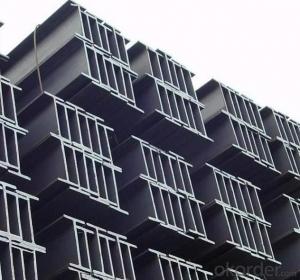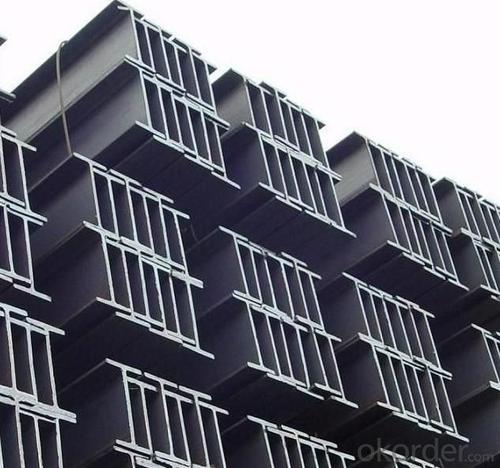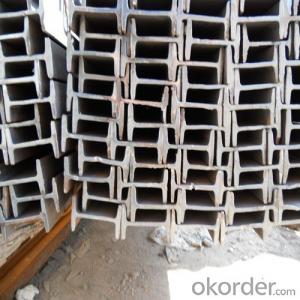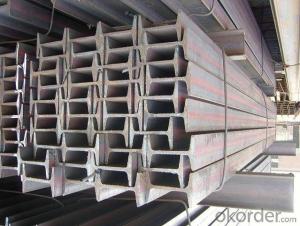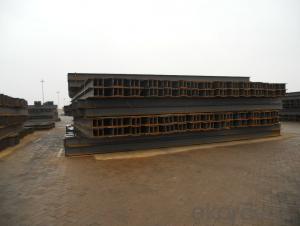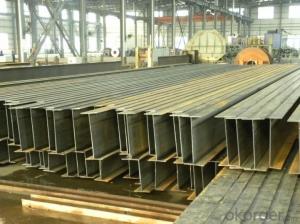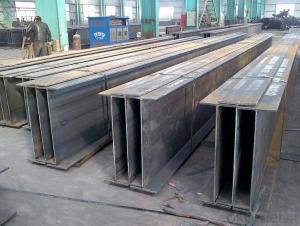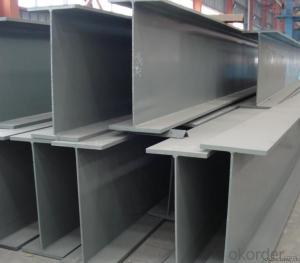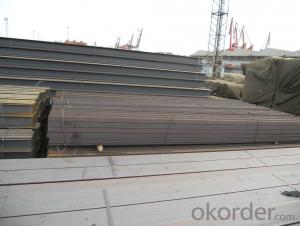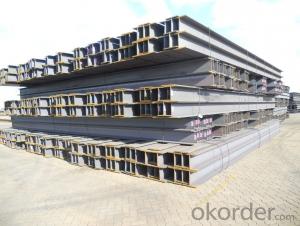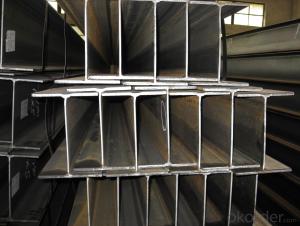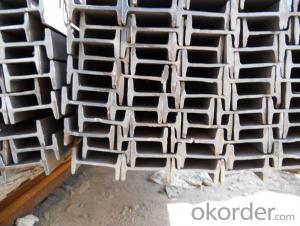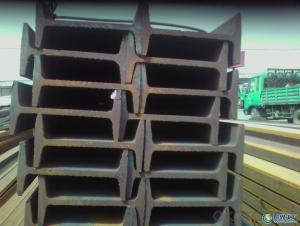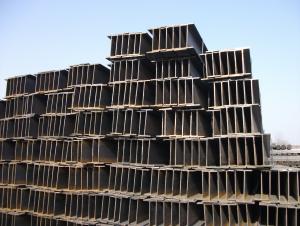Japanese Standard SS400 H beam with High Quality 446mm-498mm
- Loading Port:
- Tianjin
- Payment Terms:
- TT OR LC
- Min Order Qty:
- 100 m.t
- Supply Capability:
- 15000 m.t/month
OKorder Service Pledge
OKorder Financial Service
You Might Also Like
Specification
Specifications of Japanese Standard SS400 H beam with High Quality 446mm-498mm:
1. Standard: JIS 3192
2. Grade: SS400 or Equivalent
3. Length: 10m, 12m as following table
4. Invoicing on theoretical weight or actual weight as customer request
5.Payment: TT or L/C
Size and Mass of Japanese Standard SS400 H beam with High Quality 446mm-498mm:
| Size(mm) | Mass (Kg/m) | Size (mm) | Mass (Kg/m) |
| 458*417*30.0 | 415 | 446*199*8.0 | 65.1 |
| 498*432*45.0 | 605 | 450*200*9.0 | 74.9 |
Packaging & Delivery of Japanese Standard SS400 H beam with High Quality 446mm-498mm for Building Structures:
1. Packing: it is nude packed in bundles by steel wire rod
2. Bundle weight: not more than 3.5MT for bulk vessel; less than 3 MT for container load
3. Marks:
Color marking: There will be color marking on both end of the bundle for the cargo delivered by bulk vessel. That makes it easily to distinguish at the destination port.
Tag mark: there will be tag mark tied up on the bundles. The information usually including supplier logo and name, product name, made in China, shipping marks and other information request by the customer.
If loading by container the marking is not needed, but we will prepare it as customer request.
4. Transportation: the goods are delivered by truck from mill to loading port, the maximum quantity can be loaded is around 40MTs by each truck. If the order quantity cannot reach the full truck loaded, the transportation cost per ton will be little higher than full load.
5. Delivered by container or bulk vessel.
Usage of Japanese Standard SS400 H beam with High Quality 446mm-498mm:
(1). for the plant, high-rise building construction
(2). for the bridge, shipment building
(3).for lifting and transportation machinery, equipment manufacturing base building
(4). for the support, foundation pile manufacturing
FAQ:
Q1: Why buy Materials & Equipment from OKorder.com?
A1: All products offered by OKorder.com are carefully selected from China's most reliable manufacturing enterprises. Through its ISO certifications, OKorder.com adheres to the highest standards and a commitment to supply chain safety and customer satisfaction.
Q2: How do we guarantee the quality of our products?
A2: We have established an advanced quality management system which conducts strict quality tests at every step, from raw materials to the final product. At the same time, we provide extensive follow-up service assurances as required.
Q3: How soon can we receive the product after purchase?
A3: Within three days of placing an order, we will arrange production. The shipping date is dependent upon the quatity, how many sizes you want and the plan of production, but is typically 1 month to 2 months from the beginning of production.
Images of Japanese Standard SS400 H beam with High Quality 446mm-498mm:
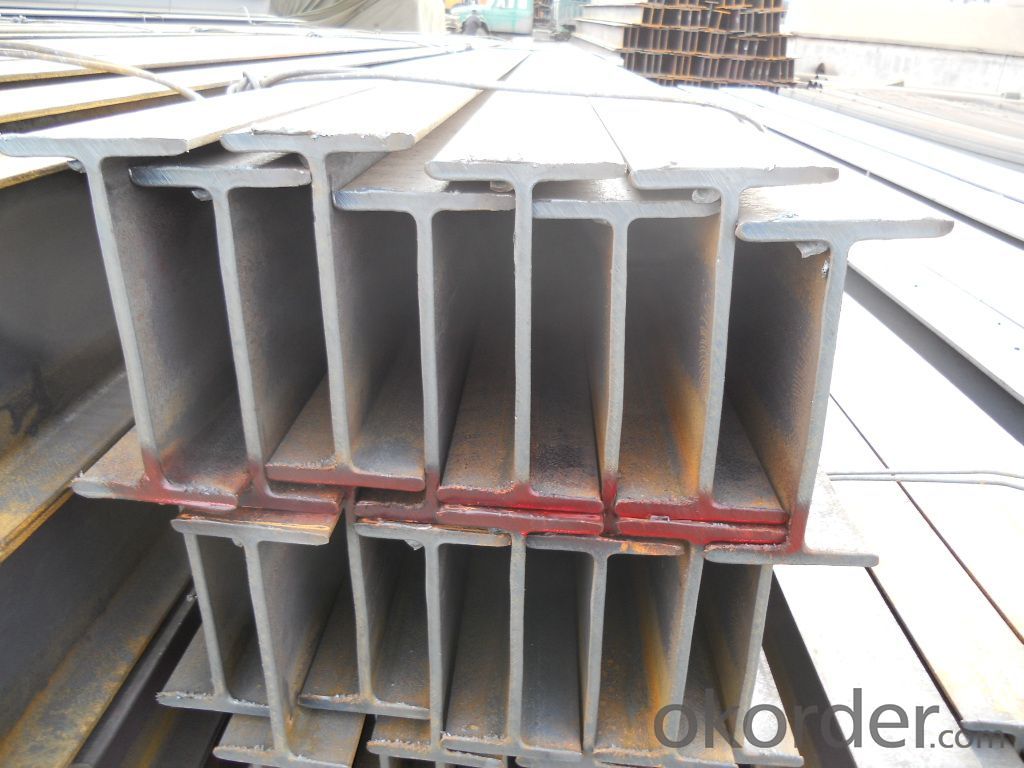
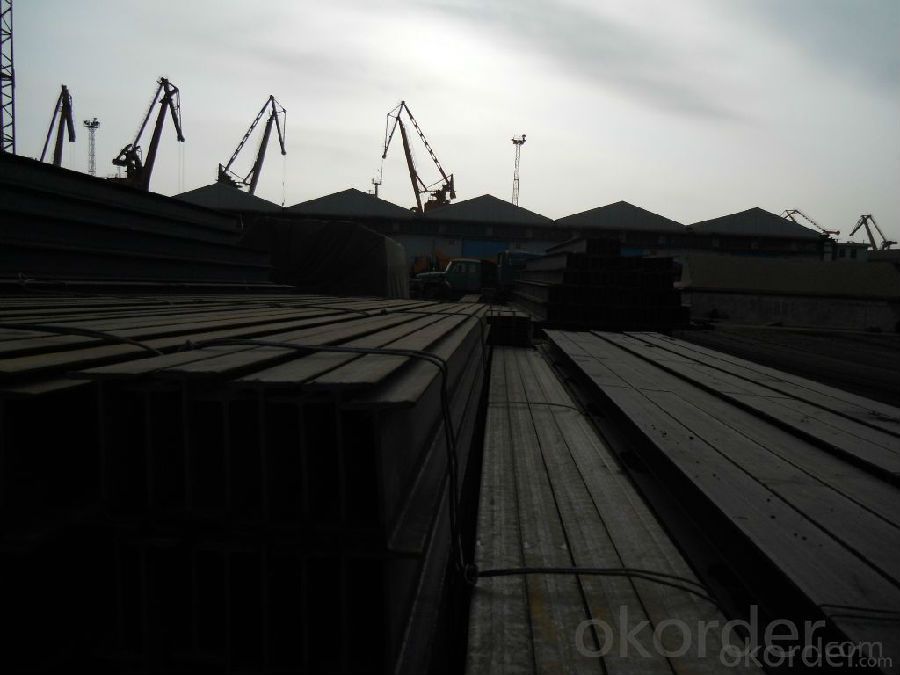
* If you would like to get our price, please inform us the size, standard/material and quantity. Thank you very much for your attention.
- Q: Can steel H-beams be used in airport hangar or aircraft maintenance facilities?
- Yes, steel H-beams can be used in airport hangars or aircraft maintenance facilities. They are commonly used in these structures due to their strength, versatility, and ability to support heavy loads.
- Q: How do steel H-beams perform in structures subjected to vibration?
- Due to their shape and material properties, steel H-beams excel in structures exposed to vibration. The H-shaped cross-section of these beams offers exceptional resistance against bending and torsional forces, making them the ideal option for withstanding vibration loads. The effectiveness of steel H-beams in dampening vibrations and reducing energy transmission throughout the structure is due to their structural rigidity and stiffness. This is particularly crucial in situations where vibrations can cause fatigue, excessive deflection, or even structural failure. Furthermore, steel is renowned for its high strength-to-weight ratio and outstanding durability, which further enhances the performance of H-beams in vibrating environments. This enables them to endure dynamic loads without significant deformation or compromising structural integrity, ensuring the long-term stability and safety of the structure. Moreover, engineers can customize the design and fabrication of steel H-beams to meet specific vibration requirements based on anticipated loads. By adjusting dimensions, material properties, and connection details, the beam's performance can be optimized to effectively mitigate vibrations and uphold the structural integrity of the system. Overall, steel H-beams are highly effective in structures subjected to vibration. Their unique shape, material properties, and ability to dampen vibrations make them a reliable and preferred choice for various applications, including bridges, industrial buildings, and other structures where dynamic loads are a concern.
- Q: How do Steel H-Beams perform in terms of sound insulation?
- Steel H-beams do not perform well in terms of sound insulation. While they provide excellent structural support, their open design allows sound to easily pass through them, making them a poor choice for soundproofing applications.
- Q: Are steel H-beams resistant to seismic forces?
- Yes, steel H-beams are generally resistant to seismic forces. Steel is a highly durable and strong material, making it suitable for withstanding seismic forces, such as those generated by earthquakes. H-beams, also known as I-beams, provide excellent structural support due to their shape, which distributes the load evenly along the beam's length. This shape helps to minimize the effects of seismic forces by effectively dissipating the energy and preventing excessive movement or deformation. Additionally, steel H-beams can be further reinforced with additional materials or techniques, such as cross-bracing or moment resisting frames, to enhance their seismic resistance even further. Therefore, steel H-beams are commonly used in construction projects located in earthquake-prone areas, as they offer a high level of resilience against seismic forces.
- Q: Are Steel H-Beams resistant to mold or mildew?
- Yes, steel H-beams are resistant to mold or mildew growth due to their non-porous and non-organic nature.
- Q: In actual steel structure engineering, why use H steel in large number, but seldom use I-beam? What's the difference between the two?
- In actual steel structure engineering, a large number of H steel is adopted, but less I-beam is used, because the section of H steel is larger than that of I-beam, and the bearing capacity is higher and the cost is lower
- Q: Can steel H-beams be used in temporary structures?
- Indeed, temporary structures can incorporate steel H-beams. In construction, H-beams are renowned for their robustness, endurance, and adaptability. They are frequently employed in the assembly of temporary structures like scaffolding, temporary bridges, or supportive frameworks for temporary stages or platforms. The exceptional load-bearing capacity of steel H-beams ensures stability and structural soundness in temporary structures. Furthermore, their modular configuration facilitates effortless assembly and disassembly, rendering them exceptionally well-suited for temporary purposes.
- Q: Can steel H-beams be used in the construction of educational institutions?
- Indeed, educational institutions can utilize steel H-beams for their construction purposes. The reason behind their widespread usage in the construction industry lies in their tremendous strength, durability, and versatility. These beams possess exceptional load-bearing capabilities and are capable of supporting heavy structures. Consequently, they are an ideal choice for educational buildings that typically necessitate spacious interiors and lofty ceilings. Steel H-beams can be employed to construct the fundamental framework of the building, encompassing columns, beams, and roof structures. Moreover, steel is an environmentally sustainable material, given its ability to be recycled and reused. As a result, it serves as an eco-friendly option for educational institutions. All in all, steel H-beams are a fitting and frequently employed choice when it comes to constructing educational institutions.
- Q: Can steel H-beams be used in retail or shopping mall construction?
- Yes, steel H-beams can be used in retail or shopping mall construction. Steel H-beams are commonly used in construction projects due to their strength, versatility, and cost-effectiveness. They provide structural support and can bear heavy loads, making them suitable for large-scale commercial buildings like retail or shopping malls.
- Q: What are the different types of connections used for steel H-beams?
- Different types of connections are utilized for steel H-beams, based on the particular application and load demands. 1. Welded Connections: Steel H-beams are commonly joined through welding, which involves melting the steel at the joint and merging it. These connections offer high strength and rigidity, making them suitable for heavy loads and structural purposes. 2. Bolted Connections: Bolts and nuts are used to secure H-beams, providing flexibility for disassembly and reassembly when necessary. This connection type is often employed in situations where easy installation and maintenance are important. 3. Riveted Connections: Although an older method, riveting can still be found in some older structures. It involves inserting metal pins, known as rivets, through pre-drilled holes and compressing them to create a permanent connection. 4. Moment Connections: When significant bending moments need to be transferred between H-beams, moment connections are used. These connections enhance rigidity and stability by resisting rotational forces, commonly found in building frames and structures experiencing heavy loads or seismic activity. 5. Shear Connections: Shear connections are designed to transfer shear forces between H-beams. This typically involves welding or bolting steel plates or angles to the webs and flanges of the H-beams, enhancing their load-bearing capabilities. 6. Pinned Connections: Pinned connections allow for rotation at the joint and are used in situations where flexibility and movement are required. These connections typically involve using pins or bolts to connect H-beams, allowing them to pivot or rotate. It is essential to consider factors such as load requirements, structural design, and specific application when selecting the appropriate connection type. Consulting a structural engineer or adhering to relevant building codes and standards is crucial when determining the most suitable connection type for steel H-beams in a given scenario.
Send your message to us
Japanese Standard SS400 H beam with High Quality 446mm-498mm
- Loading Port:
- Tianjin
- Payment Terms:
- TT OR LC
- Min Order Qty:
- 100 m.t
- Supply Capability:
- 15000 m.t/month
OKorder Service Pledge
OKorder Financial Service
Similar products
Hot products
Hot Searches
Related keywords
